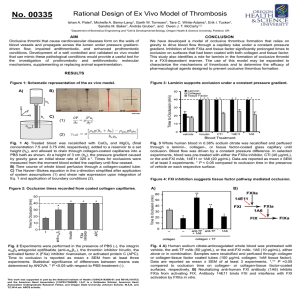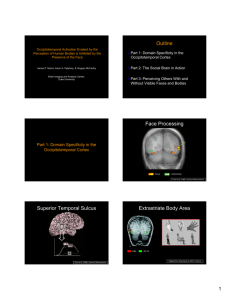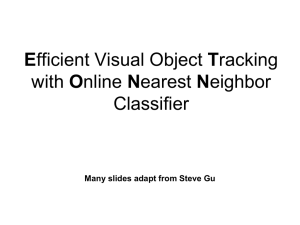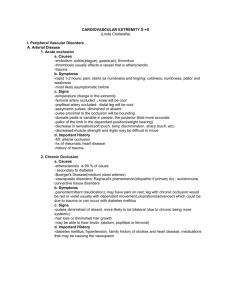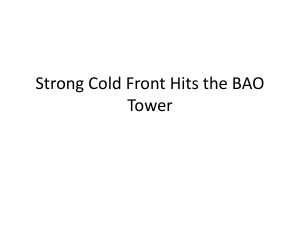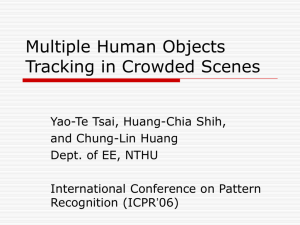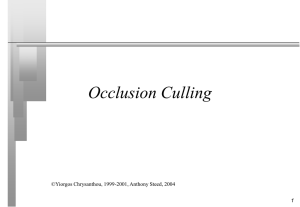OCS-14: You Can Get Occluded in Fourteen Ways
advertisement
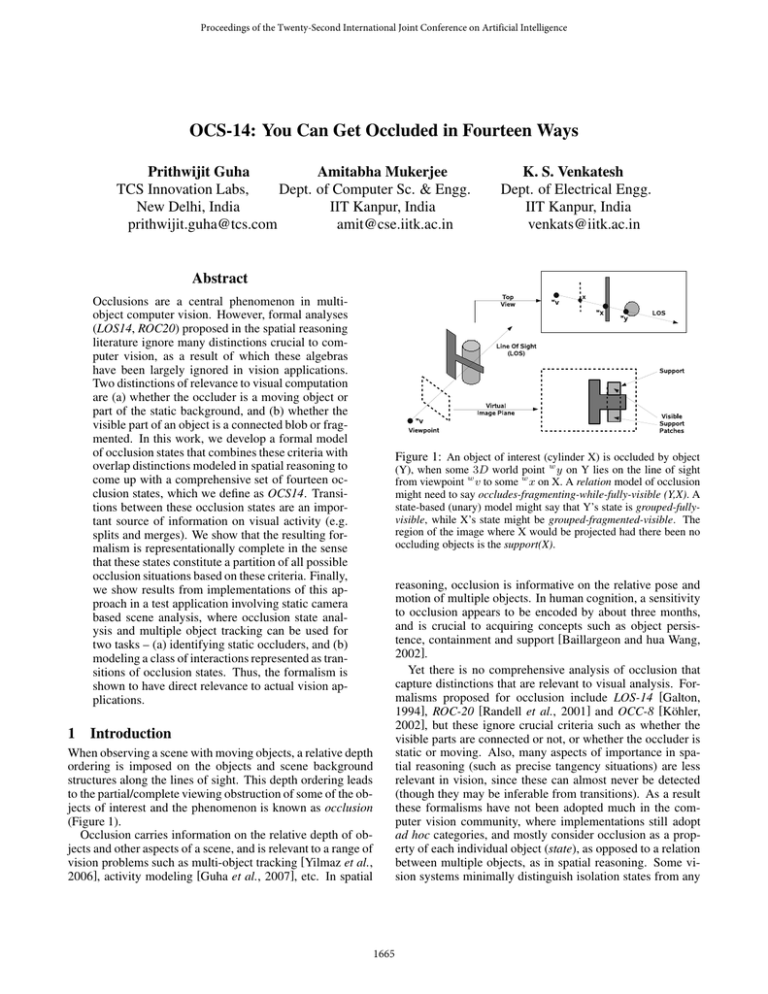
Proceedings of the Twenty-Second International Joint Conference on Artificial Intelligence
OCS-14: You Can Get Occluded in Fourteen Ways
Prithwijit Guha
Amitabha Mukerjee
TCS Innovation Labs,
Dept. of Computer Sc. & Engg.
New Delhi, India
IIT Kanpur, India
prithwijit.guha@tcs.com
amit@cse.iitk.ac.in
K. S. Venkatesh
Dept. of Electrical Engg.
IIT Kanpur, India
venkats@iitk.ac.in
Abstract
Occlusions are a central phenomenon in multiobject computer vision. However, formal analyses
(LOS14, ROC20) proposed in the spatial reasoning
literature ignore many distinctions crucial to computer vision, as a result of which these algebras
have been largely ignored in vision applications.
Two distinctions of relevance to visual computation
are (a) whether the occluder is a moving object or
part of the static background, and (b) whether the
visible part of an object is a connected blob or fragmented. In this work, we develop a formal model
of occlusion states that combines these criteria with
overlap distinctions modeled in spatial reasoning to
come up with a comprehensive set of fourteen occlusion states, which we define as OCS14. Transitions between these occlusion states are an important source of information on visual activity (e.g.
splits and merges). We show that the resulting formalism is representationally complete in the sense
that these states constitute a partition of all possible
occlusion situations based on these criteria. Finally,
we show results from implementations of this approach in a test application involving static camera
based scene analysis, where occlusion state analysis and multiple object tracking can be used for
two tasks – (a) identifying static occluders, and (b)
modeling a class of interactions represented as transitions of occlusion states. Thus, the formalism is
shown to have direct relevance to actual vision applications.
Figure 1: An object of interest (cylinder X) is occluded by object
(Y), when some 3D world point w y on Y lies on the line of sight
from viewpoint w v to some w x on X. A relation model of occlusion
might need to say occludes-fragmenting-while-fully-visible (Y,X). A
state-based (unary) model might say that Y’s state is grouped-fullyvisible, while X’s state might be grouped-fragmented-visible. The
region of the image where X would be projected had there been no
occluding objects is the support(X).
1 Introduction
When observing a scene with moving objects, a relative depth
ordering is imposed on the objects and scene background
structures along the lines of sight. This depth ordering leads
to the partial/complete viewing obstruction of some of the objects of interest and the phenomenon is known as occlusion
(Figure 1).
Occlusion carries information on the relative depth of objects and other aspects of a scene, and is relevant to a range of
vision problems such as multi-object tracking [Yilmaz et al.,
2006], activity modeling [Guha et al., 2007], etc. In spatial
1665
reasoning, occlusion is informative on the relative pose and
motion of multiple objects. In human cognition, a sensitivity
to occlusion appears to be encoded by about three months,
and is crucial to acquiring concepts such as object persistence, containment and support [Baillargeon and hua Wang,
2002].
Yet there is no comprehensive analysis of occlusion that
capture distinctions that are relevant to visual analysis. Formalisms proposed for occlusion include LOS-14 [Galton,
1994], ROC-20 [Randell et al., 2001] and OCC-8 [Köhler,
2002], but these ignore crucial criteria such as whether the
visible parts are connected or not, or whether the occluder is
static or moving. Also, many aspects of importance in spatial reasoning (such as precise tangency situations) are less
relevant in vision, since these can almost never be detected
(though they may be inferable from transitions). As a result
these formalisms have not been adopted much in the computer vision community, where implementations still adopt
ad hoc categories, and mostly consider occlusion as a property of each individual object (state), as opposed to a relation
between multiple objects, as in spatial reasoning. Some vision systems minimally distinguish isolation states from any
1.1
kind of occlusion; others provide a small set of occlusion
situations, often confusing occluding of an object with dynamic effects like merging and splitting; while others use the
term occlusion but refer only to dynamic events [Yilmaz et
al., 2006].
In vision processing, it is important to discriminate figure
(usually objects of interest which exhibit motion, e.g. vehicles, people etc.) from ground (scene components that remain static through out a video, e.g. trees, posts, walls etc.).
A moving car is a dynamic object (figure), but if it stops for
a long period as at a traffic light, it may be treated as static
(ground). A common practice in computer vision is to segment foreground objects as “blobs” (maximal connected pixel
sets). When an object is occluded by other dynamic objects,
their blobs will merge together into a single connected foreground blob, but when it is occluded only by a static object,
the occluding object will not be part of the foreground blob.
Thus this distinction becomes crucial.
In this work, we consider primarily scenes in which one
or more opaque objects are moving against a relatively stable background; the set of moving objects constitute the foreground. The relatively stable background can now be used to
segment and attend to the foreground portions.
We are interested in 3D world points w x lying on the surface of either the static background w B or on one of the
dynamic (moving) objects w Si , where each object w Si is
the surface of a connected set1 . The line joining a given
viewpoint w v with w x is the line of sight (LOS) of w x
(Figure 1). The 2D point x is the projection of w x, if
the LOS through w x intersects the image plane at x; this
is captured by the predicate isP rojection(x,w x). We are
interested in points on the surfaces of the objects exposed
to the vision sensor (w Sexp (i)). We define the predicate
pointOrderLOS(w x, w y) indicating that w x and w y lie on
the same line of sight and w x is nearer to the viewpoint.
We define the point occlusion and visibility as
≡
pointOrderLOS(w x, w y) and
occludes(w x, w y)
w
w
visible( x) ≡ z occludes(w z, w x). The set of points
exposed to the viewpoint (not occluded by the object itself) is
w
S exp (i) = {w x ∈ w S i : (w z ∈ w S i )occludes(w z, w x)}.
The projection of w Sexp (i) onto the image plane, Si ,
constitutes the maximal visible extent of w Si or its
support. The support Si for the 3D point set w Si (Figure 1) can be defined as Si = support(w Si ) = {x :
( ∃w x ∈ w Si )isP rojection(x, w x)}. This is the set
of pixels that would have been the object’s image if there
were no occluding objects. An object is isolated from
other objects, if its support does not overlap with any other:
∀k = i [Si ∧ Sk = ∅].
We can now define subset of the support that is actually visible, or the visible support of Si , as Vi =
{x : (∃w x ∈ w Si )isP rojection(x, w x) ∧ visible(w x)};
(Vi ⊆ Si ). The image foreground is then the ∪Vi , which is
divided into a set of maximally connected “visible patches”.
Relation vs State
Formalizations of occlusion in spatial reasoning are based on
binary relations that involve two objects (n-ary relations become too verbose). Relations are helpful since they permit
transitive inference and one may use tractability and other
properties from formal algebras. However, occlusions in visual contexts often involve more than two objects, and even
a 3-body relation system would have several hundred relations. Even for two-object relations, accounting for different
types of fragmentation (Figure 3(b)) [Galton, 1998] and also
the static/dynamic distinction would result in a explosion of
relational distinctions. Also, existing formalizations consider
objects to be separated in depth; however, non-convex objects
(like two humans hugging) may be occluding each other; in
k-ary situations, these relations would add many depth layers
and the relations set would further explode.
On the other hand, if we maintain just the states of the individual objects, it provides a much more compact representation, though it is not as rich (is not representationally equivalent) to the relation based model. Thus, given the set of states
of each object, the relations between them cannot be inferred,
so there is some loss of information in going from relations to
states. However, given that many objects may be interacting,
relational algebras for modeling such interactions would be
extremely large, and adopting a state-based model provides
a mechanism that makes the relevant distinctions. Also, in
many situations we are primarily interested in one object (in
attentive focus) and hence it’s states are the most relevant.
1.2
Characteristics of Occlusion
Any representation must attempt to preserve those aspects
of the problem that are relevant to the task. In our analysis of occlusion in the vision literature [Yilmaz et al., 2006],
three characteristics appear repeatedly. As discussed above,
the static/dynamic distinction is key to tracking the objects. Also, the visible support of an object may sometimes get split into multiple blobs (e.g. when broken up by
a static object in front such as a tree or lamp-post) or the
supports of different objects may merge into a single blob
(dynamic occlusions). Thus, the degree of visibility - fully
visbile, partially visible, fragmented or invisible - is an important aspect. Finally, one needs to know the state of isolation – is the object isolated or is it grouped with other
dynamic objects? These three dimensions define the important distinctions we wish to make regarding occlusions.
Of these, some aspects of visibility and isolation have been
considered in other formalisms of occlusion [Galton, 1994;
1998] which we consider in Section 2.
In most visual tasks, we distinguish two computationally
important concepts related to the object of interest – first, the
hypothetical construct that we call support Si , and second,
the actual visible region - the visible support Vi . The occlusion relations are defined based on the support’s relation to
the visible patches, and the goal is to try to infer the unknown
support based on the evidence. Given that multiple objects
are visible at once, their visible supports may overlap or fragment, resulting in a set of blobs. The objective in tracking is
to try to infer the hypothetical support on the image as best as
1
Convention: points are in lower case, point sets in upper case
and sets of point sets in bold upper case (x, S, S). Also, world
elements are pre-superscripted w , image elements are unmarked.
1666
we can. The objective in activity analysis is to use the occlusion relations to infer the nature of the action.
In constructing any representation, one cannot make all
possible distinctions. For example, fragmentation may result
in a number of fragments (say k) - each k may demand a different distinction on this dimension alone. A pragmatic compromise is to argue that for the majority of occlusion judgments it is sufficient to represent only whether the object is
unfragmented (k = 1), or is it fragmented (k > 1). This
also permits us to consider fragmentation as a special phenomenon in the degree of visibility dimension (Section 3.1).
Thus the representation proposed has three separate dimensions spanning the occlusion state space.
1. Visibility (4 states): invisible, fragmented-visible,
unfragmented-partially-visible, and fully-visible (v0,
vF , vP , v1). (Section 3.1)
2. Static/Dynamic (4 states): is the object unoccluded, or
is the occluding object static, dynamic, or both (1, S, D,
SD).
3. Isolation (2 states): isolation (I) or grouping (G).
While a formal analysis is presented in Section 3, we observe that though there are 32 possible combinations, many
are not possible, leaving us with fourteen occlusion states
(Section 4), which we call the OCS-14 (Figure 2). We next
consider the relation between our representational states and
relations in qualitative spatial reasoning.
Figure 2: The three dimensions shown in two slices - Grouping
(left slice) and Isolation (right slice). Static/Dynamic along horizontal axis, (1/S/D/SD), and the degree of visibility along vertical
axis (v1/vP/vF/v0). Many distinctions are not feasible - e.g. dynamic occlusions (with object support intersections) cannot be isolated and, we show that only fourteen discriminations (OCS-14) are
possible (Section 4).
particular attention to boundary tangency situations. Thus,
the RCC-8 calculus which makes eight distinctions for planar shapes – disconnected (DC), externally connected (EC),
partial overlap (P O), parthood with or without boundary
contacts (T P P , T P P i, N T P P and N T P P i) and equality
(EQ). The notation Ri denotes the inverse of the relation R
- e.g. A N T P P B - that A is a non-tangential proper part of
B - is the same as saying B N T P P i A. (Figure 3(a)). Note
that the P O relation combines a diverse set of overlap situations including fragmentation (Figure 3(b)). QSR models
that try to make such distinctions (see [Galton, 1998]) quickly
become too cumbersome.
Occlusions are related to these relations because projections of a pair of 3D objects onto the image plane would
maintain these relations, and adding a depth characterization would then enable reasoning between them. This proposal is fleshed out by Galton [Galton, 1994], whose lines
of sight (LOS-14) formulation (Figure 3(c)) bifurcates the six
overlap situations in RCC-8, resulting in 14 relations. Thus,
LOS-14 extends DC to “clear visibility” (C); EC to “just
clear” (JC); P O to “partial hiding” (P H and P Hi); overlap
(N T P P ) to “hidden-by” and “front-of” (H, F and inverses
Hi, F i); tangential overlap T P P to (just) cases (JHi, JF
and inverses JH, JF i); and EQ to exact hiding (EH and
EHi). Note that the hiding and front-of relations are assumed to be disjoint - i.e. object A cannot partly occlude B
and be partly occluded by it simultaneously. Permitting such
non-convex occlusions results in the ROC-20 calculus [Randell et al., 2001] consisting of the mutual occlusion relations
(M uOccP O) emerging from P O (Figure 3(d)).
We observe that relations DC, EQ, T P P and T P P i involve discriminations based on tangency, which is not an immediate concern in most situations in computer vision today
(though they may be important in future cognitive models).
Dropping these relations we have the RCC-5 calculus which
is the basis of the OCC-8 model of [Köhler, 2002]; here only
the overlap relations (EQ, P O, N T P P ) are bifurcated into
hide/front-of, resulting in eight occlusion states.
These QSR-derived formalisms are representationally
complete for degree of overlap which is similar but not the
same as degree of visibility (our analysis also includes fragmented). Also, it does not consider the static-dynamic and
the isolated-grouped distinction. Our state-based formalism
for these three dimensions is discussed next (Section 3).
3 Occlusion and Visibility
We recall the notions of support Si and visible support Vi
introduced earlier, and consider a decomposition of the support and the notion of projection from the 3D world space to
the 2D image plane. The occlusions due to which the visible
support may be smaller than the support arise due to static or
dynamic occluders, and constitute a partition on the support:
2 Occlusions as Visual Relational Algebra
Historically, there have been two approaches towards modeling occlusion; those from the computational vision perspective have been pragmatic, and the representation has been
problem dependent and idiosyncratic [Yilmaz et al., 2006].
For example, since the merging and splitting of blobs is a
phenomena of interest in vision, these are often lumped with
occlusion phenomena such as isolated vs. partial overlap.
On the other hand, in Qualitative Spatial Reasoning, representationally complete models (equivalence relations sometimes called jointly exhaustive pairwise disjoint or JEPD)
have been developed that treat occlusion as overlap, and pay
S stat (i) = {w x ∈ w S exp (i) : (∃w z ∈ w B) ∧
occludes(w z, w x) ∧ visible(w z)} : Set of points undergoing static occlusions, i.e. by visible points belonging
to the scene background.
• w S dyn (i) = {w x ∈ w S exp (i) : ∃(w z ∈ w Sj ) ∧ (i =
j)occludes(w z, w x) ∧ visible(w z)} : Set of points un•
1667
w
(a)
(a)
(b)
(c)
(d)
(e)
(f)
(g)
(h)
(b)
Figure 4: Visibility cases under static/dynamic occlusions. The
object of interest is the person in red shirt and visible patches are
outlined in blue. (a)-(d) Static occlusion by parts of tree; (e)-(f)
Dynamic occlusion by other moving objects. Both (a),(e) illustrates
full visibility (v1), but in (a) the object is Isolated, while in (e) it is
grouped with others. (b),(f) shows non-fragmented partial visibility
(vP ), while (c),(g) portray fragmented visibility (vF ). In (d),(h) the
object is invisible due to complete occlusion (v0).
(c)
(d)
Figure 3: Illustrating the region connection relations – (a) Six of the
RCC-8 region connection relations (inverses of T P P and N T P P
are excluded. (b) The multiply connected spatial arrangements that
are manifested by the same relation P O. (c) Schematic diagrams of
the LOS-14 relations, (excluding EH and EHi) [Galton, 1994]. (d)
The Mutual occlusion relations from ROC-20 [Randell et al., 2001]
(inverse relations and equality excluded).
Table 1:
Feasible visibility situations from fragmentation
(|Vpatch (i)|) and the part-hood of Vi in Si . The infeasible cases
are marked with ×
|Vpatch (i)| = 0
|Vpatch (i)| = 1
|Vpatch (i)| > 1
dergoing dynamic occlusions, i.e. by visible points belonging to the objects of interest other than the ith one.
• w S vis (i) = w S exp (i) − w S stat (i) ∪ w S dyn (i) = {w x :
(w x ∈ w S i ) ∧ visible(w x)} : Set of unoccluded visible
points.
Vi ⊂ Si
×
vP (i)
vF (i)
Vi = Si
×
v1(i)
×
The cardinality of |Vpatch (i)| can be 0, 1, or more than
1 (since we do not distinguish higher fragments). Similarly,
[Vi = ∅] , [Vi = ∅] ∧ [Vi ⊂ Si ] and Vi = Si lead to 3
possibilities. Of these 3 × 3 or 9 possibilities, only 4 are however possible due to mutual constraints (table 1), which we
call the visibility primitives (Figure 4). For example, if there
are more than one patches, it is not possible that the visible
support equals the hypothetical support. The four visibility
primitives v0, vF , vP , v1 are disjoint by construction, and
constitute a partition on the visibility dimension.
For the third dimension of isolation and grouping, we consider overlaps between the supports for the various moving
objects. An object may be isolated (disjoint from other objects of interest), or it may be grouped (occluding or occluded
by one or more moving object). Thus, there are only two
states, isolation or grouping, and this constitutes a partition
on this dimension.
By definition, each of these subsets of Sexp is disjoint, and
S stat (i) ∪ w S dyn (i) ∪ w S vis (i) = w S exp (i). The following
four situations can be derived further by using the definitions
of w S stat , w S dyn and w S vis .
w
• Only Static Occlusions ([w S stat (i) = ∅] ∧ [w S dyn (i) =
∅]),
• Only Dynamic Occlusions ([w S stat (i) = ∅] ∧
[w S dyn (i) = ∅]),
• Both Static and Dynamic Occlusions ([w S stat (i) = ∅]∧
[w S dyn (i) = ∅])
• No Occlusion ([w S stat (i) = ∅] ∧ [w S dyn (i) = ∅]) as
the object stays fully visible.
These four situations constitute the four partitions on the
static-dynamic criteria (along the horizontal axis in Figure 2).
3.1
Vi = ∅
v0(i)
×
×
4 Occlusion States
Visibility in the Image Plane
We saw that the static-dynamic analysis led to 4 cases: unoccluded, static, dynamic and both static-dynamic occlusions.
Isolation/grouping results in two states. Along with the 4
cases on the visibility dimension, these lead to 32 possible
state distinctions. However, as we show, only 14 of these
cases are actually possible (The OCS-14, Figure 2).
An occluding state where the object is dynamically occluded by another object, and is visible in a fragmented way,
would be described as dynamic, grouped, and fragmented
An image is formed at x only if x is visible, hence we define
the predicate isImage(x, w x) ↔ isP rojection(x, w x) ∧
visible(w x), which leads to the notion of visible support as
Vi = {x : (∃w x ∈ w Si )isImage(x, w x)} (Vi ⊆ Si ).
The visible support may get partitioned into several maximally connected pixel-sets or visible patches Pi (r). We
define the set of such patches as Vpatch (i) = {Pi (r) :
∀r = r[Pi (r) ∩ Pi (r ) = ∅] ∧ [∪r Pi (r) = Vi ] ∧
maximallyConnectedP ixelSet(Pi(r))}.
1668
(e.g. the cylinder of Figure 1). Such a situation may be
written in short as ocDGF . Here the notation is obtained
by concatenating “oc” for occlusion with none of “S”, “D”
and “SD” for static/dynamic distinctions; “G” or its omission for grouping / isolated; and “1”, “P ” and “F ”, “0” for
whole, part, fragmented and non-visibility respectively. Thus,
ocDGF indicates that the cylinder is dynamically-occluded,
grouped, and that it is fragmented. On the other hand, the
T-shape of Figure 1) is oG1 since it is not statically or dynamically occluded, it is grouped, and is wholly visible. Note
that each of these states may arise from a variety of imaging
situations (Figure 5).
Table 2: Binary relations corresponding to states. Objects A (states
along row) and B (states along column) are in one of the states from
ocG1, ocDGP , ocDGF and ocDG0. The possible binary occlusion relation R, read as A{R}B, is given. For example when A is in
state ocG1 and B in ocDGP , then the possible relation P H implies
A{P H}B.
ocG1
ocDGP
ocDGF
ocDG0
ocG1
JC
PHi, JFi, Fi
PHi
Hi, JHi, EHi
ocDGP
PH, JF, F
MuOccPO
MuOccPO
ocDGF
PH
MuOccPO
MuOccPO
×
×
ocDG0
H, JH, EH
×
×
×
finite set of relations. Considering the relation algebra ROC20, we see that if A is ocG1 and B is ocDGP (middle figure in Figure 5(a)), then the possible relation may be either
AP HB or AJF B or AF B. Similarly, the various combinations of states result in different binary relations from ROC-20
as shown in Table 2. Combinations of ocDGP or oCDGF
is possible only for non-convex objects and result in mutual
occlusion (M uOccP O) relations from ROC-20.
Note that the objects in the same state combinations can
realize different occlusion relations based on their extent of
overlaps. Within these four states of dynamic occlusion we
can realize all the relations of ROC-20 formulation. More
so, we can distinguish the cases of fragmentation or multiple
connected regions in a simpler way, which otherwise would
have taken a huge burden of formulating a large number of
relationships if expressed by changing depth ordering in the
modes of overlap formulation [Galton, 1994].
(a)
(b)
(c)
5 Applications of Occlusion States
(d)
The discourse in computer Vision circles places occlusion in a
consistently negative light - as something that has to be overcome to obtain the correct tracking results and so on. A typical tracking application may use occlusion states to determine
the update rules - different update mechanisms are used when
the object is isolated vs when under static occlusion, and one
may cease updates altogether once it is in a multi-group situation.
However, cognitively, occlusion may be one of the more
significant sources of qualitative depth (ordering) information. Occlusion transitions are an important visual signature
of the interaction between objects. Through the formal analysis presented above, it becomes possible to use data mining
techniques on the occlusion transitions as they emerge in a
scene, and one can gain useful abstractions about the scene
and the object behaviors.
We exemplify this with two fixed-camera visual surveillance tasks on a simple image sequence (Figure 6). Even
in such simple scenes, not every distinction presented in the
analysis above is recoverable in the computational process.
In particular, the applications outlined below discard the distinctions between the fragmented and grouped states.
In the first task, we attempt to (a) impose a depth-ordering
on the background w B using the analysis, (b) mine the occlusion transitions to learn an event signature for a single action,
Figure 5: Illustrating the occlusion states. Rectangle: object under
consideration. Oval: other dynamic object(s). Saw-tooth: occluding
boundaries of the scene background (open-ended). (a) No occlusion – states oc1 and ocG1 signify full visibility, in isolation or in a
group respectively. In state ocG1, there are many relative situations
with the other object while the rectangle maintains full visibility. (b)
Static occlusions – under static occlusions while grouping, ocSGP ,
ocSGF and ocSG0 represent single-part, fragmented and no visibility. Many configurations exist for ocSGP and ocSGF . Under
static occlusions in isolation, states ocSP , ocSF and ocS0 indicate
similar distinctions. (c) Dynamic occlusions – A dynamically occluded object is always grouped; states “ocDP G”, “ocDF G” and
“ocDG0” signify the visibility distinctions. (d) Both Static and Dynamic occlusions – “ocSDP G”, “ocSDF G” and “ocSDG0” exhibit similar distinctions.
4.1
How do occlusion states map to relations?
We observe that in many occlusion states, the object under
consideration can be in differing occlusion relations with the
interacting object (e.g. the state ocG1, Figure 5(a)). Consider
two interacting objects A and B, and let their occlusion states
be one of the four dynamic states: ocG1, ocDGP , ocDGF
and ocDG0. Now, each state combination corresponds to a
1669
and (c) use occlusion characteristics to query a surveillance
video and obtain all similar events. The camera is looking at
a tree behind which several people are walking around (only
one episode is shown). The object color distribution and support are updated only in isolated conditions to provide the
tracker with most recent and confident features [Guha et al.,
2007]. The “walk past the tree event” is detected as a transition from the initial state of oc1 to ocSP since there are no
other dynamic objects and ocSGP is ruled out. In repeated
episodes, the occlusion boundary always occurs at this part of
the image, and it is detected as a high-frequency static edge.
(a)
(b)
(c)
(d)
Figure 6: Extracting information from the spatial distributions of
occlusion states. (a)-(c) Results of tracking a person (marked by
a red rectangle) walking across a tree. (d) The white pixels mark
the spatial distribution of the states of static occlusions. Note that it
rightly captures the occluding boundaries of the tree.
For learning the event signatures, we take the temporal
transition patterns of the occlusion primitives and model these
using Transition Sequence Mining (TSM) trees which are
clustered using tree-depth weighted Bhattacharya distances
[Guha et al., 2007]. We discover different multi-object interactions in the surveillance context. In this particular situation, there are no other objects so we focus on the walkbehind-the-tree episode. This corresponds to a pattern of
oc1 → ocSP → ocS0 → ocSP → oc1, irrespective of
which direction the person is walking from. This is a common occurrence in a large number of multi-object interaction situations - where a relatively small object walks behind
a parked vehicle or a pillar or a tree and re-emerges on the
other side. Querying the TSM trees with the time ordered sequences of the occlusion states detects similarities with other
events where this type of sequences arose, thereby detecting
episodes of the transit-across-a-large-occlusion event. Thus,
in both these problems, we can see how occlusion information is actively used to obtain information about a scene.
6 Conclusion
Our main contribution lies in the identification of a representationally complete set of fourteen occlusion states (OCS14) based on the three characteristics used often in existing
work in vision – viz. nature of occluder. visibility, and isolation/grouping. We have argued for a state-based formalism
for modeling occlusion in visual phenomena as opposed to a
binary or k-ary relation algebra. We have also presented two
applications which demonstrate how, unlike previous formal
models, this algebra can be actually used in visual computation. The ad hoc references to occlusion situations in existing
literature (mainly static camera applications in computer vision) now have a formal model for representing their occlusion states as per application necessities, which is the prime
benefit of our proposed formalism.
1670
One of the questions related to applying such formalisms in
real tasks is that the distinctions highlighted by the formalism
must be recoverable in the computation. As seen in the application above, this is unlikely, especially with dynamic occlusions. Nonetheless, they may provide possibilities which
may be of user interest; also in future, they may become computable.
A large number of issues remain. A theoretical issue of
interest is the analysis of the conceptual neighborhood for
these occlusion states - these are meaningful in identifying
neighboring transitions. For example, a transition such as
oc1 → ocS0, without going through a state such as ocSP ,
is likely to indicate some kind of error, missed state, or other
problem. Such a conceptual map for OCS-14 has been identified, but space precludes us from adding it here.
As shown by the applications, the very fact that a coherent
and complete representation is available opens up many possible applications for this approach. Beyond the applications
to models of tracking etc, issues of occlusion are of great importance in forming a stable conceptualization of the world.
Regions of frequent occlusion clearly reveal important information about the scene depth and also about object behaviors
in the given scene context. Thus, a object moving behind
a screen and repeatedly appearing on the other side tells us
something about these objects, and can also prime the visual
attention system towards the exit point. Such models lead
eventually to a stable realization of the object permanence in
the visual scene, which is a key cognitive goal of vision [Baillargeon and hua Wang, 2002].
References
[Baillargeon and hua Wang, 2002] Renée Baillargeon and
Su hua Wang. Event categorization in infancy. Trends
in Cognitive Sciences, 6(2):85–93, February 2002.
[Galton, 1994] Antony Galton. Lines of sight. In Proceedings of the Seventh Annual Conference on AI and Cognitive Science, pages 103–113, 1994.
[Galton, 1998] Antony Galton. Modes of overlap. Journal
of Visual Languages and Computing, 9(1):61–79, 1998.
[Guha et al., 2007] Prithwijit Guha, Amitabha Mukerjee,
and K.S. Venkatesh. Pattern Recognition Technologies and
Applications: Recent Advances. Idea Group Inc., 2007.
[Köhler, 2002] Christian Köhler. The occlusion calculus.
In Workshop on Cognitive Vision, Zürich, Switzerland,
September 2002.
[Randell et al., 2001] David Randell, Mark Witkowski, and
Murray Shanahan. From images to bodies: Modelling and
exploiting spatial occlusion and motion parallax. In International Joint Conference on Artificial Intelligence, pages
57–63, 2001.
[Yilmaz et al., 2006] Alper Yilmaz, Omar Javed, and
Mubarak Shah. Object tracking: A survey. ACM Journal
of Computing Surveys, 38(4), 2006.
